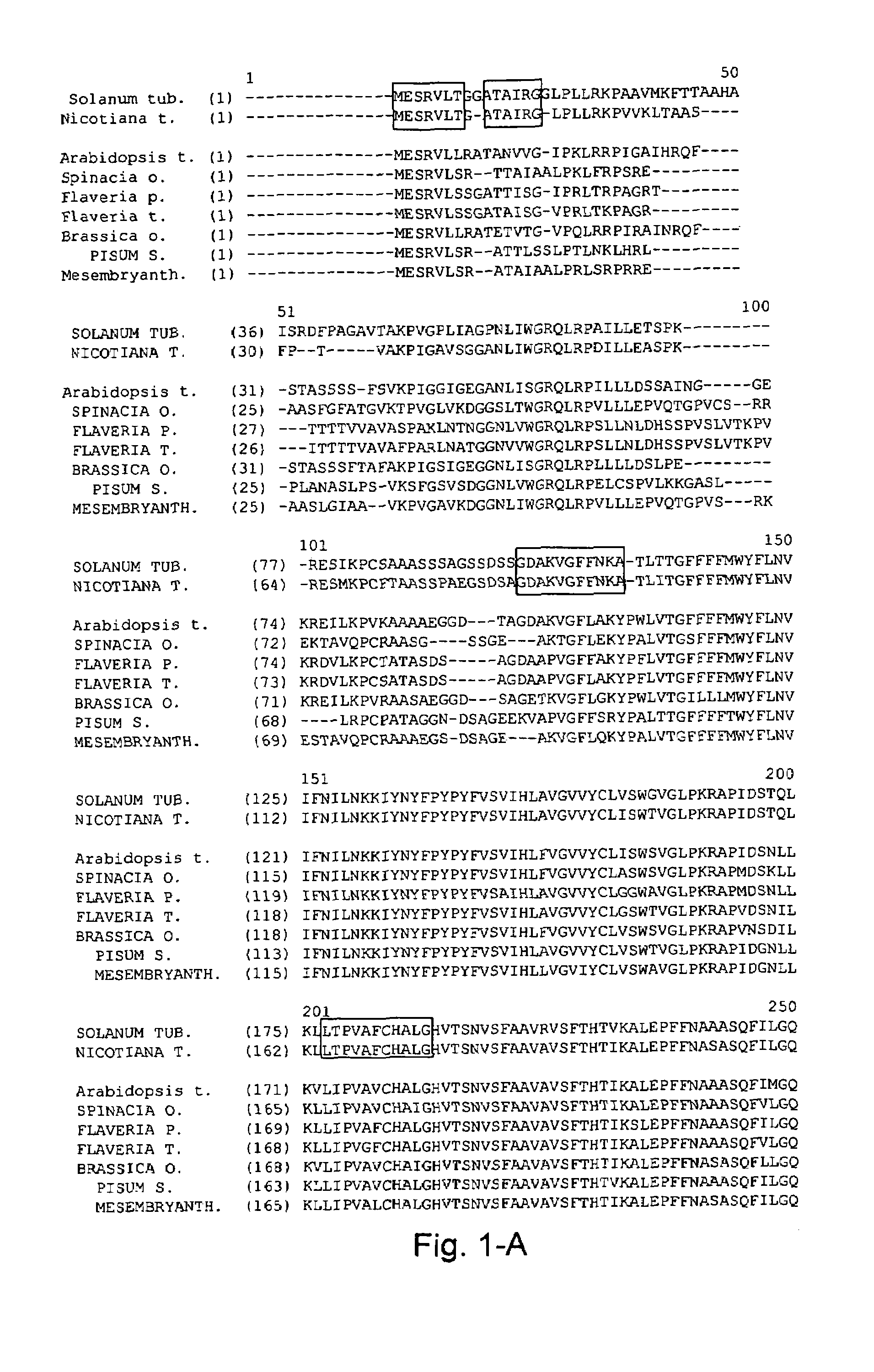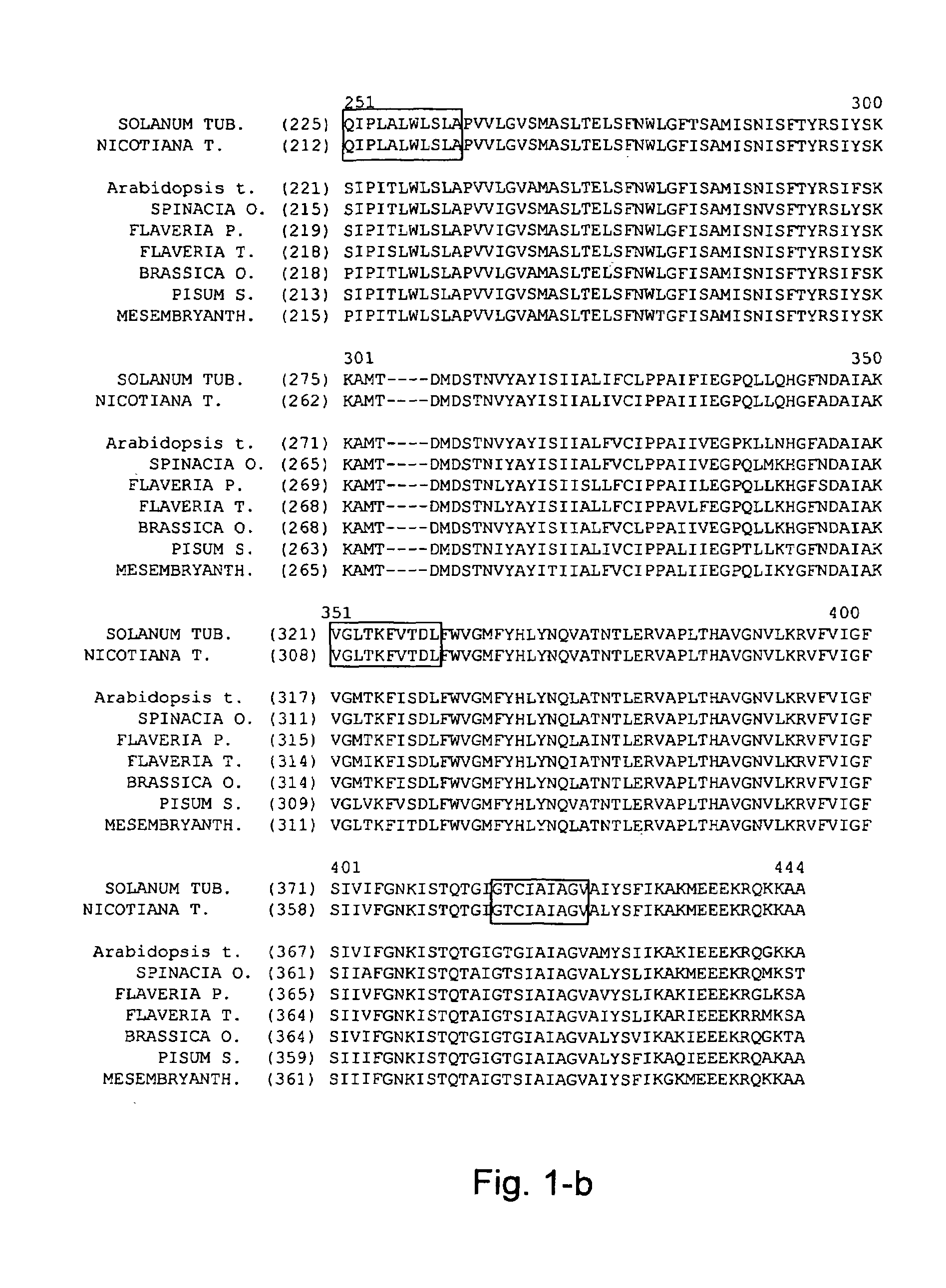Transcription Regulating Nucleotide Sequence from Solanaceae Triose-Phosphate Translocator Genes and Their Use in Plant Expression Cassettes
a technology of transcription regulation and transcription regulation, which is applied in the field of transcription regulation nucleotide sequences from solanaceae triosephosphate translocator genes and their use in plant expression cassettes, can solve the problems of toxic effect, inability to allow for a broad expression profile in all other tissues, and disadvantageous expression in these tissues, so as to reduce the stringency of hybridization media
- Summary
- Abstract
- Description
- Claims
- Application Information
AI Technical Summary
Benefits of technology
Problems solved by technology
Method used
Image
Examples
example 1
Generation of Transgenic Potato Plants
[0374]For generating transgenic potato plants Agrobacterium tumefaciens (strain C58C1[pMP90]) is transformed with the promoter::GUS vector construct (see below). Resulting Agrobacterium strains are subsequently employed to obtain transgenic plants. For this purpose an isolated transformed Agrobacterium colony is incubated in 4 ml culture (Medium: YEB medium with 50 μg / ml Kanamycin and 25 μg / ml Rifampicin) over night at 28° C. With this culture leaf disks and internodes from in vitro potato plants are infected and 2 days co-cultivated in the dark. Thereafter explants are transferred on solid MS medium, where sucrose is replaced by glucose (MG). (KIM: 1×MG-medium, 1.65% glucose, 5 mg / l NM, 0.1 mg / l BAP, 250 mg / l Timentin and 40 mg / l kanamycin) and cultivated (21° C., light / dark rhythmus 16 h / 8 h). After callus phase explants are transferred on shoot induction medium (SIM: 1×MG, 2 mg / l zeatinribosid, 0.02 mg / l NAA, 0.02 mg / l GA3, 250 mg / l timetin, ...
example 2
Demonstration of Expression Profile
[0375]To demonstrate and analyze the transcription regulating properties of a promoter of the useful to operably link the promoter or its fragments to a reporter gene, which can be employed to monitor its expression both qualitatively and quantitatively. Preferably bacterial β-glucuronidase is used (Jefferson 1987). β-glucuronidase activity can be monitored in planta with chromogenic substrates such as 5-bromo-4-Chloro-3-indolyl-β-D-glucuronic acid during corresponding activity assays (Jefferson 1987). For determination of promoter activity and tissue specificity plant tissue is dissected, embedded, stained and analyzed as described (e.g., Baumlein 1991).
[0376]For quantitative β-glucuronidase activity analysis MUG (methylumbelliferyl glucuronide) is used as a substrate, which is converted into MU (methylumbelliferone) and glucuronic acid. Under alkaline conditions this conversion can be quantitatively monitored fluorometrically (excitation at 365 n...
example 3
Primers and Conditions Used for Cloning from Genomic DNA
[0385]The cloning using the genome walker strategy implies the use of a great number of PCR cycle, and also the possibility of chimeras promoters that could be obtained during the ligation process when genomic DNA library are constructed cannot be excluded. To overcome this possibility, it was chosen to first design a new set of primers using the sequence of the promoter region of the plasmid pDTPT-Ma105, and then to amplify directly from the potato genomic DNA with this set of primers using the high fidelity PfuTurbo DNA polymerase (Stratagene).
Primers Used:
[0386]Primer sequences were as follow with the restriction sites SalI, XbaI (left primer), SmaI and BamHI (right primer) included in the primers for subsequent cloning:
L-DTPT-M105: (5′ primer for the promoter amplification, 52mer; SEQ ID NO: 12) 5′ GTCGACTCTAGAACTAATTCTTATATTATMATTCCTAC ATT ACT MT CTG C 3′ Start with SalI and XbaI restriction sites (in bold characters) for ...
PUM
| Property | Measurement | Unit |
|---|---|---|
| Tm | aaaaa | aaaaa |
| temperatures | aaaaa | aaaaa |
| nucleic acid sequence | aaaaa | aaaaa |
Abstract
Description
Claims
Application Information
 Login to View More
Login to View More - R&D
- Intellectual Property
- Life Sciences
- Materials
- Tech Scout
- Unparalleled Data Quality
- Higher Quality Content
- 60% Fewer Hallucinations
Browse by: Latest US Patents, China's latest patents, Technical Efficacy Thesaurus, Application Domain, Technology Topic, Popular Technical Reports.
© 2025 PatSnap. All rights reserved.Legal|Privacy policy|Modern Slavery Act Transparency Statement|Sitemap|About US| Contact US: help@patsnap.com


